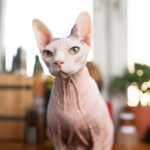For many of us, our homes are not just houses, but sanctuaries filled with things we love. High on that list for many are both lush indoor plants and our cherished feline companions. The desire to bring the outdoors in with houseplants is often paired with the responsibility of ensuring a safe environment for our cats. It’s a valid concern – some houseplants can pose a real threat to cats if ingested, leading to symptoms ranging from mild discomfort to severe health issues. Even the most well-behaved cat might be tempted to explore and nibble on a tempting green leaf. To help you create a beautiful, green home that’s also safe for your feline friends, we’ve curated a guide to House Plants Safe For Cats, ensuring you don’t have to compromise between your love for plants and the well-being of your pets.
1. Chinese Money Plant (Pilea peperomioides): The Cat-Friendly Coin Plant
The Chinese Money Plant, with its distinctive coin-shaped leaves, is not only a stylish addition to any interior but also completely non-toxic to cats. Its unique foliage adds a touch of whimsy, and its easy-to-grow nature makes it a rewarding choice for plant enthusiasts of all levels. These plants are known for producing “pups,” or baby plants, adding to their charm and shareability – perfect for gifting to fellow plant-loving, cat-owning friends.
Cat-Friendly Care Instructions:
- Light: Chinese Money Plants thrive in medium to bright indirect light. Placing them on a windowsill that receives filtered sunlight is ideal.
- Watering: Water every 1-2 weeks, allowing the soil to dry out slightly between waterings. Overwatering can lead to root rot, so it’s better to err on the side of underwatering.
- Rotation: To ensure even growth, rotate your Pilea 180 degrees each time you water it. This prevents it from leaning too much towards the light source, maintaining a balanced and aesthetic shape, especially important if it’s in a spot accessible to curious paws.
2. Money Tree (Pachira aquatica): Good Fortune, Safe for Felines
Money Trees are not only believed to bring good luck and prosperity but are also a safe choice for homes with cats. Their miniature tree-like appearance, often featuring braided trunks and shiny, fast-growing leaves, adds a unique structural element to indoor plant collections. These resilient plants can withstand a bit of feline curiosity, making them a practical and attractive option for cat owners.
Cat-Friendly Care Instructions:
- Light: Money Trees prefer medium to bright indirect light. Avoid direct sunlight, which can scorch their leaves.
- Watering: Water every 1-2 weeks, allowing the top inch of soil to dry out between waterings. They are relatively drought-tolerant, so it’s better to underwater than overwater, especially if your cat tends to knock over pots and you want to minimize mess.
- Placement: While sturdy, consider placing your Money Tree in a location less prone to accidental bumps from playful cats, especially if it’s a larger plant. A stable pot is also recommended.
3. Hoya Varieties: Beautiful and Non-Toxic Options for Cat Lovers
The Hoya family offers a diverse range of beautiful, non-toxic plants perfect for cat-friendly homes. From the classic Hoya Carnosa with its variegated leaves to heart-shaped Hoyas and those with unique, curly foliage, there’s a Hoya for every style. Their thick leaves and woody stems give them a succulent-like quality, making them relatively resilient and low-maintenance, ideal for busy cat owners.
Cat-Friendly Care Instructions:
- Light: Hoyas thrive in bright, indirect light, which encourages faster growth and more vibrant colors in variegated varieties. They can tolerate lower light conditions, but growth will be slower.
- Watering: Water Hoyas sparingly. In bright light, water when the leaves begin to feel thin and slightly wrinkled, about every 1-2 weeks. In low light, watering may only be needed once a month. Overwatering is a common issue and can lead to root rot, so let the soil dry out thoroughly between waterings.
- Placement: Hoyas can be vining plants, so consider hanging them or placing them on shelves where their foliage can cascade down, keeping them out of easy reach of cats who might be tempted to chew on dangling leaves.
Choosing house plants safe for cats doesn’t mean sacrificing style or greenery in your home. These are just a few examples of the many beautiful and non-toxic options available. Always remember to double-check the ASPCA’s extensive list of toxic and non-toxic plants for the most comprehensive information and to ensure a happy, healthy, and green home for both you and your feline companions.

